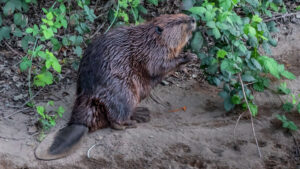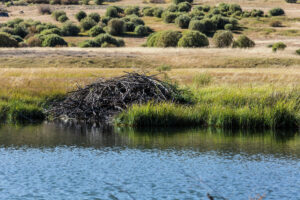We are winding out the new year with good news. Yesterday Randi wrote back very enthusiastic about how she might be involved with the festival. Elizabeth Winstead agreed to help us out with Worth A Dam and this article was released this morning. 2022 has been a beavery year. And it’s going out with a bang.
Beavers are making a comeback in the San Francisco Bay Area
 The recent discovery of two beavers sighted along Matadero Creek in Palo Alto could be a sign of a major comeback for the species in the Bay Area.
The recent discovery of two beavers sighted along Matadero Creek in Palo Alto could be a sign of a major comeback for the species in the Bay Area.
Naturalist Bill Leikam, who is the co-founder and president of the Urban Wildlife Research Project, captured trail camera footage of the semiaquatic rodents wandering along the waterway late last month, as the Mercury News first reported. He set up the cameras after he had been tipped off by a resident who claimed to have seen one while they were meditating on the side of the creek, and sure enough, there they were — a male and a female. Now, Leikam treks along the waterway twice a day to check the cameras and scour the beavers’ new home for signs of their whereabouts, finding clues in the form of paw prints in the mud and tooth marks on ash trees. He’s hopeful the pair could help reestablish the species’ population in the area.
I hope so too. Although its hard to wish beavers a nice time in San Jose. It’s such a hard place to find a future. Promise me you’ll stay in the water guys. Never try to cross the streets okay?
Beavers are native to Northern California but were nearly hunted to extinction during the California fur rush in the 1800s, when maritime traders converged in the Bay Area and California’s Central Coast to harvest the valuable, chestnut-colored fur from the species, as well as otters, seals, mink and other mammals. Fewer than a thousand beavers were still living in the state by 1912, according to Brock Dolman and Kate Lundquist, who are co-directors of the Occidental Arts and Ecology Center’s WATER Institute and have been researching beaver restoration for the past decade.
“When you remove a keystone species like beaver, which were managing the retention of water, slowing of floods, and the preservation of wetland … that was the first step of the dehydration of the state,” Dolman told SFGATE. He thinks it’s “very likely” that beavers showing up in the South Bay are the descendants of other beavers that were relocated to the Lexington Reservoir by the California Department of Fish and Wildlife more than four decades ago. Since then, beavers have also established near Los Gatos Creek, Guadalupe River, Coyote Creek, Palo Alto, Martinez and Walnut Creek, according to observations recorded on the social media app iNaturalist, Lundquist said.
That’s not the half of it of course. We have beavers in Fairfield and beavers in Pleasant hill and beavers in Mountain house. The question is how long are they allowed to stay?
Every beaver sighted is a promising sign for the experts. Dolman and Lundquist said the animals can help recover near-extinct species like coho salmon by creating new wetland habitats and encouraging the growth of the plankton and insects they feed on. Beaver dams can also more broadly restore natural ecosystems, slowing down water flow and improving water quality by preserving sediment and nutrients in streams. Ken Paglia, a spokesperson for the California of Fish and Wildlife, said that beavers’ efforts to retain water can mitigate drought impacts, support climate change resiliency, and also potentially stop or slow the spread of wildfire moving through an area.
“Having beaver show up in a creek where they haven’t been for a long time can be a really positive thing,” Lundquist said, adding that juvenile beavers typically have a 45% survival rate and can face a number of challenges when re-establishing in a new territory. “In these systems, we’ve seen water pooled and bank burrows for animals to hide in during high flows. That can create biodiversity oases where creatures drawn to water show up more often. More birds, mink and other species that might not otherwise be there are emerging because there’s this area being managed by beaver that attracts and supports all kinds of wildlife.”
Hooray! It’s wonderful to read such nice things about Bay Area beavers. But honestly I can’t help but feel…I’m sure after the first suffragettes were jailed and forced fed and imprisoned and starved over and over so that decades later women ACTUALLY got the vote and could talk to the press cheerfully about how great it was to vote with their husbands and brothers, Susan B. Anthony rolled one eye at the news paper and said, yeah yeah yeah. It’s great now. But bloody hard hard lonely grueling work got us here. And don’t you forget it.
 Damion Ciotti, a coastal program manager for the U.S. Fish and Wildlife Service, said that beavers can also help reconnect streams to floodplains and provide a natural, alternative to habitat restoration work that would typically require heavy equipment and costly engineering. In 2018, he teamed up with the Placer Land Trust to work on a project with beavers at Doty Ravine, and said he was amazed to find that the animals swiftly expanded the habitat from a narrow stream corridor to 50 acres of floodplain.
Damion Ciotti, a coastal program manager for the U.S. Fish and Wildlife Service, said that beavers can also help reconnect streams to floodplains and provide a natural, alternative to habitat restoration work that would typically require heavy equipment and costly engineering. In 2018, he teamed up with the Placer Land Trust to work on a project with beavers at Doty Ravine, and said he was amazed to find that the animals swiftly expanded the habitat from a narrow stream corridor to 50 acres of floodplain.
All we did was simply allow the beaver to start building their dams on the site,” he said. “It’s a 40 to 50 pound rodent, yet it can have a major influence on a stream system. Arguably, we end up with better projects as a result of beavers because we’re working directly with nature to design and build a habitat instead of going out and building it ourselves.”
Very nice Damion. We are grateful every DAY for what you managed to achieve in Placer. It’s a hard place to sell beaver benefits, truly.
Not everyone is excited about beavers moving into their backyards as their populations increase. While the animals do help to manage the landscape, their presence can result in minor flooding. “Or they can chew down your favorite tree,” Lundquist said.
However, the California Department of Fish and Wildlife approved a new program earlier this year that will fund a team of five environmental scientists whose work will be focused on educating the public about beaver restoration and coming up with nonlethal strategies for people and beavers to peacefully coexist.
“We can show people how to put in a flexible pond leveler, for instance, or wrap a wire around a tree,” Lundquist said. “This helps make sure we can keep the beaver in place but minimize the damages they may cause.”
It’s a significant step forward after years of advocacy, meetings, and “sometimes heated discussions,” Lunquist said. “This is a huge moment in California history.”
Again, I’m seeing the jailed suffragette with the feeding tube raising her eyebrow and saying HEATED DISCUSSIONS? Tell me about it.
There was a sniper behind the screen at our beaver meeting and 11 police officers lined up in front of it. I guess that was kinda heated.







































